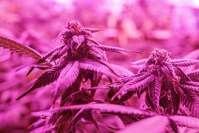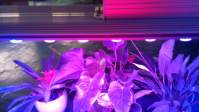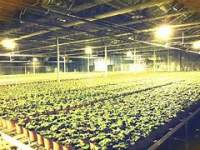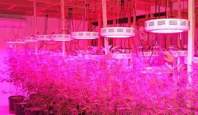As the indoor gardening world continues to grow in size and complexity, LED lighting manufacturers are deploying various standards and selling points to make their lights unique. All these complicated mathematics actually boil down to some very simple indicators, professional growers can use these indicators to effectively compare the quality and performance of today's LED plant growth lights.
PAR: Light suitable for plant growth
Traditional industrial and commercial applications of LED lighting are designed to illuminate the work space for human activities. This means that the only important spectrum is the very narrow central curve perceived by the human eye, and we measure it in lumens.
The number of available lumens in a given area is an accurate measurement of the light output and coverage of these applications. The relationship between plants and light is very different, so the way we measure light in gardening is very different.
All plants draw nutrients and growth cues from natural sunlight, and respond to a wider range of lighting chromatograms that humans usually perceive. The spectrum that affects plant growth is in the 400 to 700 nanometer range, involving more red and blue at the end of the spectrum. Because of its positive role in photosynthesis, we call this light photosynthetically active radiation (PAR).
LED plant light manufacturers will advertise the PAR level produced by their lamps, but there are some other key indicators that accompany the PAR output, which really separates ordinary light from high-quality LED LED plant lights.
Indicators of LED plant lights
For evaluating the performance standards of today's most prominent LED grow lights, you need to consider two important factors;
• The amount of PAR produced by light, measured as photosynthetic photon flux (PPF).
• The amount of PAR that actually reaches the plant, as measured by photosynthetic photon flux density (PPFD).
Photosynthetic photon flux (PPF)
PPF measures and quantifies the amount of PAR emitted by LED plant lights. This is calculated in micromoles per second (μmol/s) and should be publicly available from the manufacturer. This is an important indicator to check when evaluating the value of a given LED plant light, because PAR is only a part of the total light produced by the lighting fixture. When your focus is on stimulating photosynthesis, PPF is a good indicator that can indicate the degree of nourishment of a given light to the growth cycle of the crop. A high level of PPF means that the lamps are adjusted to generate a large amount of PAR and support healthy growth, which is a good sign of return on investment.
Photosynthetic photon flux density (PPFD)
PPFD goes one step further. It is good to produce a large area of PAR that nourishes the plant, but if the beam spread is a wide-spreading method, then only a small part of the PAR will actually reach the leaves of the plant. The rest will overflow onto the aisles and walls, which is basically a waste of energy. PPFD measures the density of PAR that actually reaches the plant canopy.
In addition to the high PPFD value, it is important that the light is evenly distributed on the crop. Hot spots or black spots can cause overexposure or underexposure of plants to available PAR and negatively affect the overall harvest quality. This uniformity is a challenge for LED plant lights, but there are some interesting innovations in this field.
The LED plant light produced by Yaorong Technology uses precise optical elements on each diode to focus the beam on the plant and provide precise uniformity throughout the canopy, thereby making the overall harvest healthier. Make sure that the PPFD measurement value you receive from the LED lighting manufacturer is the combined average of multiple measurement points from the entire canopy.
We can also supplement the light-filling skills through adjustment methods:
1. Install evenly distributed
Measure the floor area. Multiply the length by the width to get the square meters of the planting area. You can make the right choice based on how much power to provide per square meter, that is, how many LED plant lights are installed per square meter. In this way, each lamp can be evenly distributed, so that the outer edge will receive strong light, so that the light will be more uniform, and the growth of plants will be more effective.
2. Illumination distance
The lighting distance of LED plant lights is very important. You should adjust the points for different plants at different stages, and you must also unify the distance to make the light even more uniform. If the distance is not well controlled, it may harm the growth of plants. The general recommendation is that the germination stage distance: 60 cm, the seedling stage distance: 75 cm, the growth stage distance: 45 cm, and the flowering stage distance: 30 cm.
3. Lighting time
The lighting time of LED plant lights is mainly determined according to plants, which are divided into two types, positive plants and negative plants. Positive plants are more light-loving, and the lighting time can be longer when supplementing the light, usually 18/6 (on/off) or 20/4 (on/off). For negative plants, the lighting time is normal, usually 12/12 (on/off).
4. Dimming level
The dimming of LED plant lights can make plants grow better at each stage, the general germination rate: 30%; seedlings: 50%-75%; growth: 75%-100%; flowering: 100%. Give plants the best growth status.
5. Humidity, temperature
Photosynthesis and transpiration rate are directly affected by temperature, humidity and airflow. Find the best temperature and humidity for your plants between 75*-85*F and 50%-70% humidity, and have sufficient airflow to replenish carbon dioxide.
Practical functions of LED plant lights:
1. Use LED plant lights to illuminate plants: extend the light time, increase the light intensity, and reduce the growth cycle of plants;
2. It can effectively prevent overgrowth of plants and grow more orderly;
3. It can increase crop yield and economic benefits;
4. It can effectively prevent the invasion of pests;
5. Promote flowering and fruiting of melon and fruit plants and reduce the formation of deformed fruits;
6. It can completely replace sunlight, and the plants can thrive when planting plants in winter;
7. It can effectively promote the formation of chlorophyll, anthocyanin and carotene required for plant photosynthesis;
8. It can be used for space plant system and space planting;
9. Wide application environment, such as large-scale planting, multi-layer tissue culture, local lighting, home bonsai, etc.
Nine advantages of Yaorong LED plant lights:
1. No standard power socket connectors for drivers or cooling fans are required.
2. An environment with red and blue wavelengths is required for plant growth.
3. Compared with other ordinary lighting equipment, the LED plant light has a gentler light line and will not scorch the seedling plants.
4. Compared with other plant lighting, it can save 10%~20% of the electricity bill.
5. Blue light can promote plants to grow taller, and red light can promote flowering and fruiting of plants.
6. Reduce cultivation costs and extend flowering period;
7. Promote early maturity of plants, increase production, and improve the quality of melons and fruits;
8. Ensure the taste of vegetables in greenhouses and realize off-season cultivation;
9. Inhibit the reproduction of germs and pests, and make it green without pollution.
The technology of LED plant lights is constantly improving and progressing, and they are widely used in agricultural planting to provide a variety of plants for people's lives. The future development of LED plant lights will be better and the prospects are promising.






